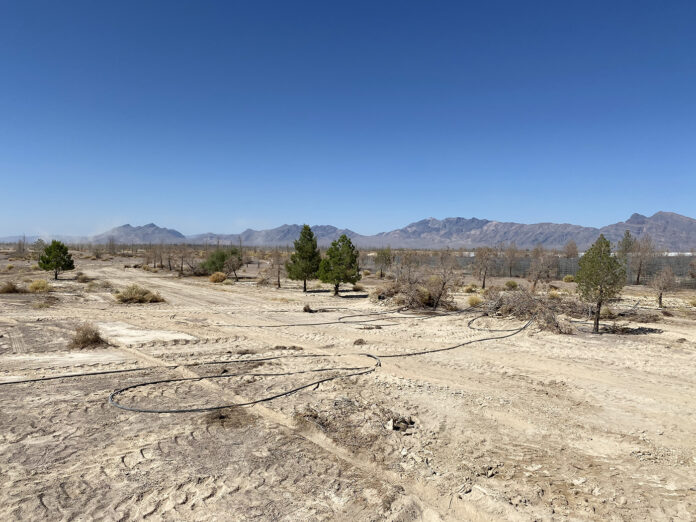
Cultivators can benefit economically and sustainably from utilizing regional natural resources to grow cannabis outdoors. The indoor growing movement began as a reaction to the need to hide from law enforcement; as legalization measures continue to pass across the country, cultivators may begin opting for more cost-effective and sustainable outdoor cultivation.
Desert operations
The Nevada desert provides an excellent model for cannabis cultivation in the West. MJ Holdings Inc. specifically set up in the Amargosa Valley because of the groundwater supply alone. Amargosa Valley is a basin in southern Nevada that straddles the Nevada/California state line, approximately ninety miles northwest of Las Vegas. The basin itself contains more than 22,000 acres of water, according to Nevada’s Department of Conservation and Natural Resources.
In this region, water is otherwise sourced from Lake Mead (pumped by the Colorado River) and is becoming increasingly scarce due to climate change. For the first time ever, the federal government recently declared a drought on the Colorado River. CNN reported Lake Mead—the largest reservoir by volume in the United States—has drained at an alarming rate in 2021 and is at its lowest point since being filled after completion of the Hoover Dam in the 1930s. The historically low water levels will exert enormous pressure on all cannabis cultivators who rely on Lake Mead to hydrate their grows.
Instead of relying on Lake Mead, the Amargosa Valley utilizes an ancient aquifer to provide drinking water to all households and businesses. The area’s unique geological configuration maintains the water at 55°F as it travels through a natural underground filtration system. By the time the liquid reaches its destination, it contains natural nutrients like magnesium and calcium that enrich cannabis plants.
Sustainable practices
By utilizing natural sunlight, growers minimize the need for pesticides, insecticides, and other synthetic chemicals. The hot desert sun acts as the ultimate disinfectant: Ultraviolet light kills both mold and bacteria. The extremely dry heat inhibits parasite growth on its own, as most parasites can’t survive in the desert’s high temperatures. Additionally, the ecosystem is home to many lizards, ladybugs, praying mantises, and lacewings, which rapidly multiply and eat pests.
Soil is another critical puzzle piece. Outdoor soil provides the ultimate natural environment for cannabis plants. Using coco coir or rockwool is effective for indoor growing, but at MJ Holdings, we’ve found natural soil maximizes the plants’ terpene and cannabinoid profile, along with yields. Our compost tea mixes sea kelp, bat guano, worm castings, and molasses to strengthen and feed the soil, increasing beneficial bacteria the plants consume through their roots.
Natural airflow is yet another benefit of outdoor cultivation. Plants can aspirate naturally since they’re not contained within air that is cleaned, scrubbed, and recirculated. Indoor operations draw thousands of kilowatt hours of power to cool and filter contained air at a very high volume.
Lighting also requires enormous amounts of electricity, and it simply doesn’t produce the same terpene and flavor profiles as natural sunlight. Equipment developers produce grow lamps that mimic the sun, but I maintain they’ve never gotten the spectrum entirely right.
Opportunities
The deserts in the southwestern U.S.—such as those in Arizona, Nevada, and New Mexico—present a great opportunity for outdoor grows because summer seasons are long and winters are slow to set in. Despite its less ideal climate, even the Pacific Northwest has rich, nutritious soil to offer. With the right timing, outdoor cultivation can happen virtually anywhere.
And soon enough, it will. Cultivating cannabis outdoors is increasing in popularity, particularly with the expansion of commercial cultivation markets. Once federal legalization is enacted, outdoor grows are poised to dominate the industry due to environmentally friendly practices and a cost-effectiveness that confers consumer-price advantages. Growing outdoors also helps the concentrate market: Extractors are taking note of the cannabinoid and terpene profiles produced by natural sunlight and soil.
No matter where cultivators are located, today’s industry offers opportunities to reach new heights by taking advantage of the abundant natural resources available all around us.

MJ Holdings Inc. founder and Chief Cultivator Paris Balaouras has more than ten years of experience developing and operating legal cannabis businesses, including license acquisition, facility management, cannabis cultivation, and legislative initiatives. Prior to founding MJ Holdings, he served as managing partner at Acres Medical LLC and principal officer at Natural Remedy Patient Center. He is a member of the Nevada Dispensary Association, Americans for Safe Access, and NORML.







